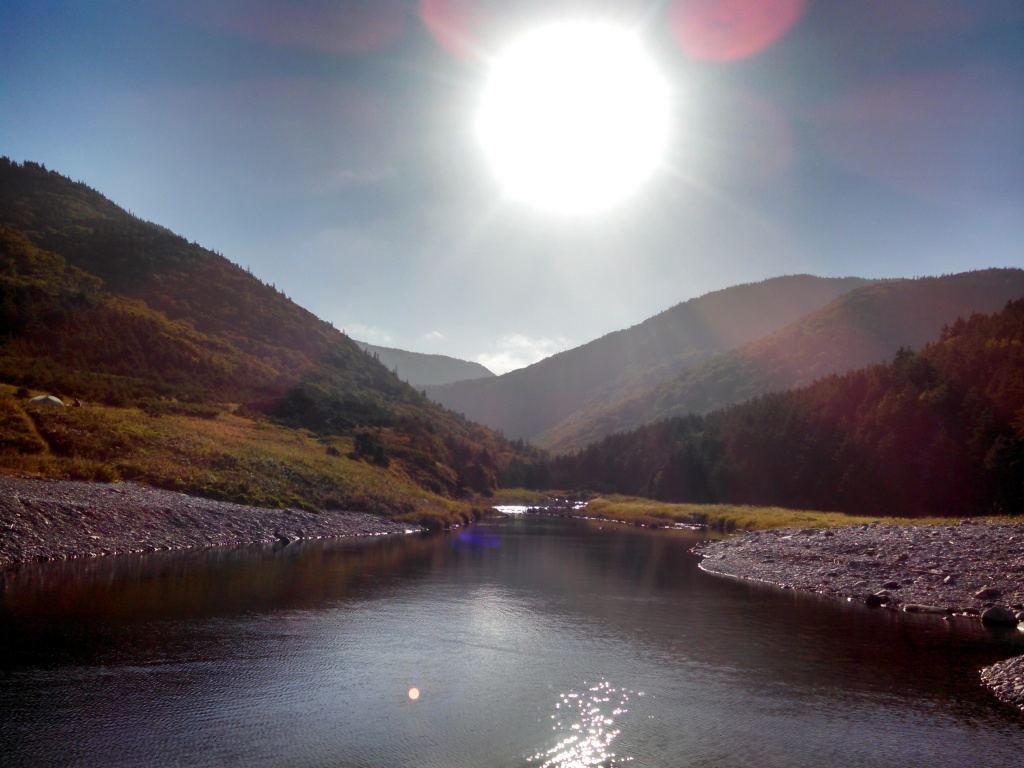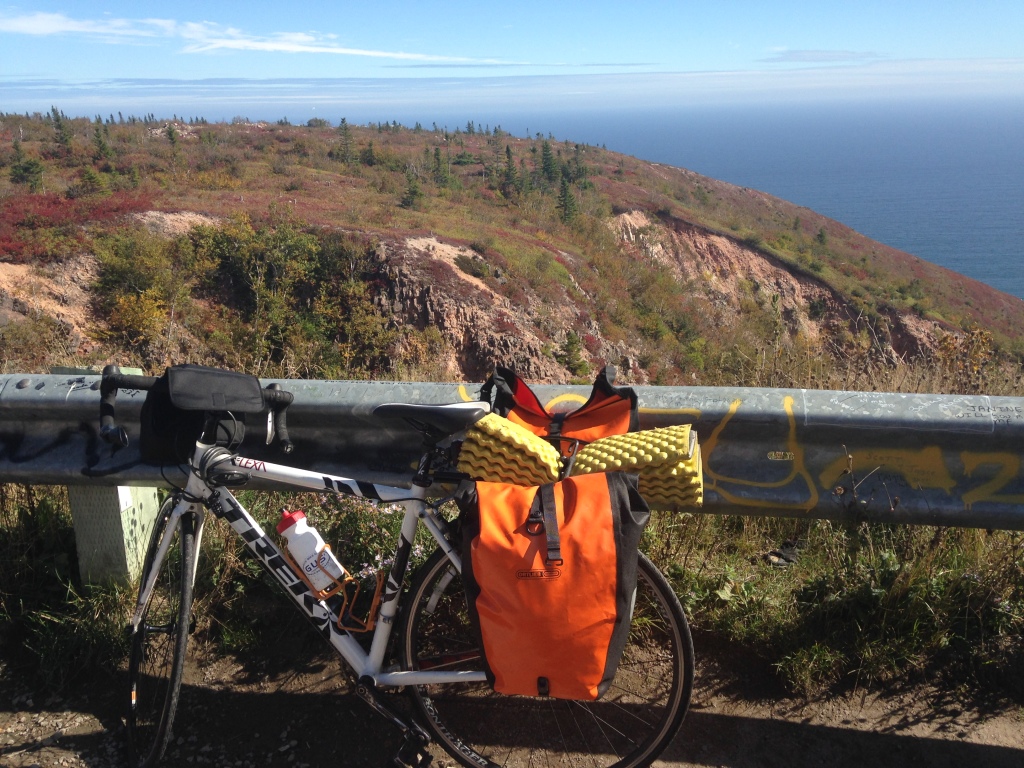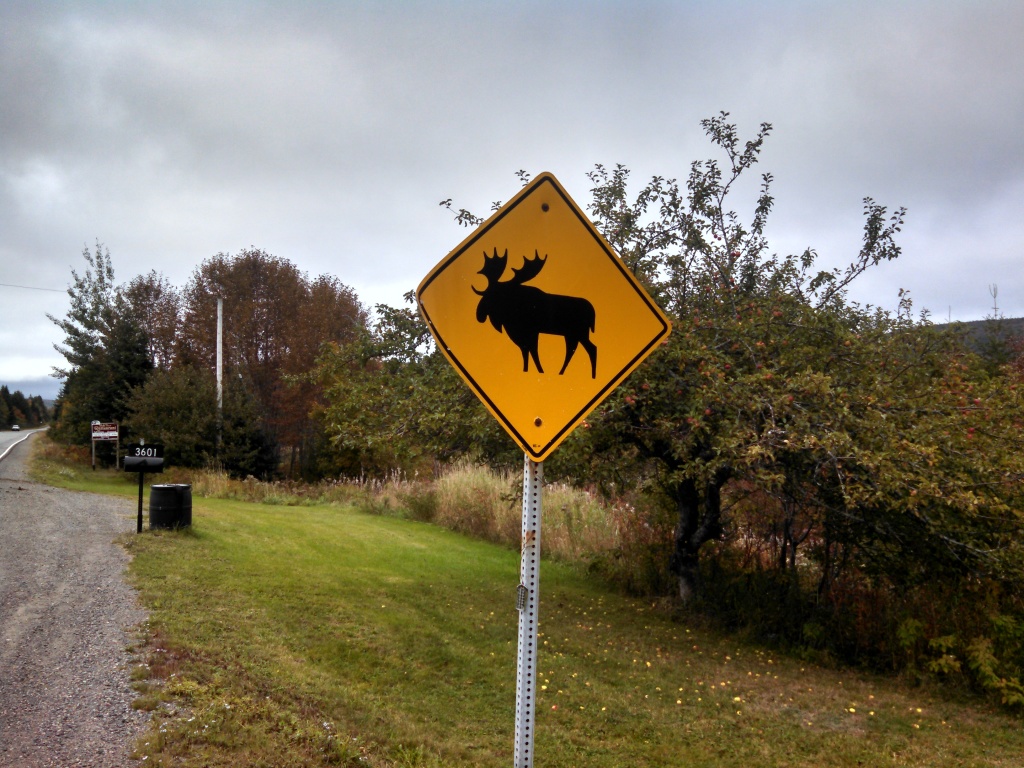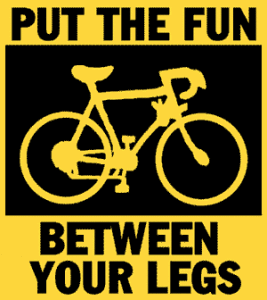Cycling The Cabot Trail: Nova Scotia’s 185-Mile Gem
“ It’s rutting season for the moose.” The ranger told us as we hovered over our bike seats, our loaded panniers seeking to unbalance us. She handed us our park pass through the window of her booth, smiling. “And the Coyotes have been pretty scrawny lately.” Her syllables were dressed with the round, pleasant sound of a Canadian accent and it sounded more like she was offering us a slice of pie than advising us about our position in the food chain. She frowned for a moment. “If they give you any trouble, try to use your bike as a shield.”
Why were we here?
Because:

Bike touring the Cabot Trail has been on my bucket list for years. Located on the NorthEasternmost edge of Nova Scotia, it is a 185-mile loop around Cape Breton, frequented by tourists in campers, cars, motorcycles, or, on occasion, bikes. The wide road passes through the Highland’s National Park and a handful of small coastal fishing villages, and was named one of the top ten cycling destinations in the world by Lonely Planet. With massive bluffs covered by heather-strewn highlands, steep rocky cliffs that descend down to crashing waves, and more wildlife sightings in six days than I experienced in the entirety of my Appalachian Trail hike, the Cabot Trail was wild.

So what do you need to know to embark on this adventure yourself?
Getting there
First of all, it’s very far away. Located 8 hours by car from Baxter State park, northeast, Cape Breton is not easy to access. That’s part of its charm. So, if you’re up for the challenge, your options for getting there are:
Driving the mainland, which, if you’re not residing in New England, is a serious haul. This is probably the cheapest way, however, and there are plenty of places to park your car in Baddeck if you choose to cycle the trail. Just bear in mind that you have to drive through Maine and New Brunswick, and most of Nova Scotia. Which takes eleven hours. That’s a lot of I-spy.
Taking a Ferry – There are several ferry options, but the best known is to take the nova star from Portland Maine to Yarmouth, Nova Scotia, and drive up Nova Scotia. The trip will be prettier and will feel much faster with the luxury of a cruise ship. The downside? It will hurt your wallet (at close to $500 round trip for one person and their car, it’s not cheap), and you’ll be surprised to find that the trip actually takes much longer with the ferry involved (a 10 hour ferry trip, plus driving time to Portland, ME and the 7 hour drive from Yarmouth to Baddeck), although you’re too busy playing shuffleboard to notice.
Flying (expedia.com) – You can fly to Sydney, NS from any major airport, and from there it’s a quick drive (in Canadian terms) to Baddeck. You can kick back, get groped by TSA, and watch an inflight movie while you drink a tiny beverage. The downside? From Boston to Sydney is roughly an 8 hour flight and an hour-long drive (saving you maybe 2 hours total if you’re in New England already). It’s at least $700 round-trip, and you have to rent a car on top of it.

So what’s the take-away advice for getting there? If you live in New England, drive. If you’re not a Yankee, take a plane.
Which brings us to…
Bike Rentals
Let’s say you don’t want to break apart and transport your bike on the plane. Or you don’t want to drive all day long with your prized bicycle dangling precariously from your Subaru (a nerve wracking experience). You can rent bikes from Cabot Trail Outdoors which come complete with a rack for your panniers, a bike rack for your car, and even a guarantee from the company that they will personally pick you up if you break down. Although, for the record, every local stopped to chat with offered us the same service. Cape Breton is a friendly place.
Where to stay

There are dozens of hotels, hostels, and B and B’s along the way on the Cabot Trail, but if you are headed there in the prime season (June – September), I would recommend booking ahead of time. At least for the weekend nights you’ll be there. We had little trouble with finding a spot in October, with the exception of the one Saturday night that we were on the trail. In fact, we were able to take advantage of some off-season rates while there.
Camping is highly possible but keep in mind you’re in a national park! There are several designated campsites (which I HIGHLY recommend, especially Fishing Cove) and you can backcountry camp IF you clear it with the rangers first. Pack in, pack out. Hence the picture of a dead coyote on our litter bag:

Food
We could find very little information about food online, so we brought a lot of dehydrated meals. To help avoid the extra weight, you should know that there is a co-op or grocery supply in every town you will pass through, as well as numerous restaurants. While I would never recommend any long distance trip without at least one backup meal (inspired by my hoarding days on the AT), if you are going to hit a town that day, you don’t need food for that day.
I usually advise against stopping at a lot of restaurants while bike touring because that’s the easiest way to hemorrhage money, but I think Cape Breton should be an exception. With fishing driving their economy, you can find cheap, amazing seafood anywhere on the island. The dingier looking the shack, the better the chowder. The best fish and chips we had were from a little hut on the side of the road. The best lobster we witnessed was being sold out of the back of a truck. Take advantage of it!

Maps
Good luck. Maps for the Cabot Trail are woefully limited, although you can contact Andre from VeloMax cycling for a quick write-up of the sections of the Cabot Trail (Also some good description here), and the Nova Scotia tourism board will happily send you a road map. Your best resource is the Cape Breton Highlands National Park map, which can be downloaded online and is also supplied when you enter the park. Unfortunately, it only contains the portion of the trail that meanders through the park, leaving you with 80 miles of roadway unaccounted for.
So what do you do?
Wing it.
Plan on a certain number of miles per day and book places accordingly. Then show up and go for it. There is only one road, so you won’t get lost. Bring whatever basic map you have available to you and make sure to talk to locals along the way! They are your best resource, and Canadians have made a sport out of hospitality. They are the most accommodating people on earth.

Training
Bike touring is a lot like hiking the AT; you can get into shape as you go. Of course, for a 3 – 6 day trip such as the Cabot Trail, I would recommend you start in decent shape to avoid hating everyone and everything in Canada. Try doing some 20 mile bike loops a few times a week leading up to the event. Running and hiking are not bad cross training, but the best way to get in shape for biking is – surprise! – biking.
I recommend you train on hilly terrain and bike with the full weight you intend to carry. You don’t want to be adjusting to your pannier weight for the first time on the Cabot Trail. Don’t let its little ‘mountains’ fool you; you might not be climbing more than 1200 feet at a time, but your ascents will be very steep (sometimes 13% grades for 2 – 3 miles) and hills will be frequent. Much like the AT, the Cabot Trail has many PUDS (pointless ups and downs), so bring your climbing legs.
Gear
Well, you’ll need some Panniers to start. Then you’ll need to get used to every non-cyclist you talk to thinking you’re saying ‘panties’. Panniers are the gear bags that hang from the back rack on your bike (which you will also need). Ortlieb makes fantastic waterproof ones in bright, neon colors. Like hiking, you will be concerned with your weight (If you can’t fit your gear in two panniers, you have too much) and you will be dressed like a mismatched highlighter (only instead of hunters, you are now trying to catch the attention of motorists).
I talked about the bike maintenance gear you might want to carry with you in this article, but Andre from VeloMax in Cheticamp (the Cabot Trail bike shop), an avid cyclist himself, won’t bat an eye at helping you out of a pinch. And don’t forget a couple changes of bike shorts, bike gloves, wicking shirts, your camping essentials, a helmet, and warm weather gear.

Weather
Cape Breton Island sits on the Gulf Stream, which means it benefits from warm winds and Indian summers, despite being at the same latitude as Northern Maine. Check out the averages here. During our early October trip, the coldest temperatures we experienced were in the 40s at night, while daytime usually brought about 60 degree weather. Just prepare for some headwinds if you’re there in the shoulder season (October or May)!
Wildlife

After riding away from our ominous ranger encounter at the entrance to the Highlands National Park, we immediately notice a scruffy brown coyote watching us from the side of the road.
Years of cycling have prepared me to defend my ankles against disgruntled dogs, but I was suddenly terrified by the real prospect of being bitten by an animal who hunts for survival rather than entertainment. It didn’t help that my bright orange panniers I purchased for ‘safety’ have turned me into flashy, slow moving prey. What motivation to pedal harder, up into the safety and elevation of the highlands.
Camping at night, we were delighted to realize we were all alone. At least, until we heard the snorting, snuffling sounds outside of our tent. We had bear bagged our food and cooked several yards away from our tent, but still this intruder circled our tent for an hour. Finally I fell asleep, mumbling to Mark that ‘it’s just a porcupine.’
Heading out of the park several days later, we mention our porcupine encounter to a ranger.
“We have no porcupines here. What you heard was a bear.” His lively Acadian French accent made the proclamation sound much more theatrical, which might have caused us to doubt its veracity. After all, we had hiked the entire AT and barely (hahaha) been bothered by these skittish East Coast brown bears. Mostly we watched their chubby haunches retreating into the woods as if they were frightened raccoons.
“What else could it have been?”
He smiled a little sheepishly and repeated, “A bear.”
“But… but we hung all of our food.”
“Yes, but you are food too.”
After that, we made sure there were other campers nearby.

After our first night in the park, we saw four moose, several bears and coyotes, and countless grouse. We regularly woke up to the shrill cawing of bald eagles, and we surprised more animals than people as we pedaled quietly along the tops of the bluffs. On the East Coast, it doesn’t get much wilder than Nova Scotia.
But what if I’m poor?
Want to get into bike touring but don’t have the resources to fly to a remote island? The great thing about bike touring is that you can go almost anywhere cars can go (and some places they can’t.) Check out Adventure Cycling for a list of bike touring options near you.
You also don’t need the newest touring hybrid or fancy waterproof panniers to do it. You can make your own panniers, and the first bike I ever toured on was a beat up Trek mountain bike that I found for exactly zero dollars (well, apprehended from my brother is more accurate, but you can find an old Trek for less than $20 these days). If I could lug my gear over four thousand miles on that mule, I guarantee you can do the same. Is it comfortable and convenient? No. But neither is long distance hiking.
When we’re looking back on our trips, it’s often the things that went horribly wrong that made it an adventure. If your homemade pannier strap didn’t break, if your old tires didn’t blow on the uphill, if you didn’t get completely, horribly lost because you didn’t have a fancy GPS on your bike, you wouldn’t have the same experience. You would have someone else’s experience. Someone with more money and security. Personally, I always recommend the low budget option. Which is why, instead of letting vans take our gear and experienced cyclists plan our camping spots, we almost puked grinding up the steeper-than-we-realized North Mountain and spent one of our honeymoon nights being sniffed by a bear. Because pure luxury makes a terrible blog post.
This website contains affiliate links, which means The Trek may receive a percentage of any product or service you purchase using the links in the articles or advertisements. The buyer pays the same price as they would otherwise, and your purchase helps to support The Trek's ongoing goal to serve you quality backpacking advice and information. Thanks for your support!
To learn more, please visit the About This Site page.


